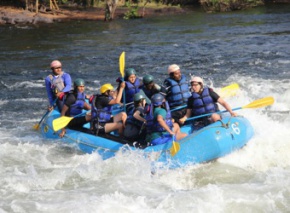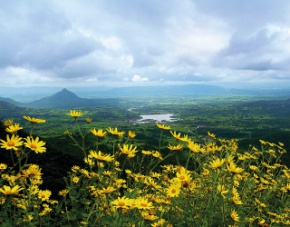
A trip to Vietnam should at least be 5 nights and 6 days so that it allows students to explore these activities curated for this module comfortably, with clear learning outcomes.
Given below are a few activities that can be conducted at this destination, along with the appropriate age group. Our forte is customisation, so feel free to select ONE, ALL or ANY combination of these activities to design a trip unique to your curriculum and experiential learning needs.
This expedition is focussed on developing outdoor skills in the tropics of Vietnam. It offers excellent exploration opportunities apart from focus on non-tangible attributes like teamwork, leadership, self-belief and dynamic thinking triggered through outdoor adventure sports.
Using eco friendly mountain bikes, students will have the opportunity to cycle across the varied terrain of Cat Tien National Park. The objective is to improve upon endurance and skill through exposure to varied levels of difficulty on each day. Cat Tien comprises an amazingly biodiverse area of lowland tropical rainforest.
The 72,000-hectare park is one of the outstanding natural treasures in Vietnam, and the hiking, mountain biking and bird-watching here ,are the best in the south of the country. Fauna in the park includes 100 types of mammal including the bison (gaur), 79 types of reptiles, 41 amphibian species, plus an incredible array of insects, including 400 or so butterfly species. Of the 350-plus birds, rare species include the orange-necked partridge and Siamese fireback. A visit to the bear rescue centre at the Park Headquarters will also provide information about the species conservation actions taken to protect the regions’ biodiversity.
A kayaking trip in the mangrove forest will give students an opportunity to understanding the river ecosystems of the region. With 40,000 hectares of diverse habitats including mangroves, palm-fringed islands, steamy jungle, wetlands and salt marshes, students will kayak (all safety gear and expert guidance provided) through the astonishingly bio-diverse riverscape.
Nam Cat Tien national park, as previously mentioned, is one of Vietnam's last surviving protected forested areas and home to some key endangered species including the pygmy slow loris, yellow-cheeked gibbons, sun bears and guar. Exploring this tropical paradise on foot, will teach students skills of jungle survival, endurance and empathy for the forest and its resident species.
Canyoning is traveling in canyons or waterfalls using a variety of techniques that may include other outdoor activities such as walking, scrambling, climbing, jumping, abseiling (rappelling), and swimming. We will conduct a full day activity in Dalat, where the students will learn about basic skills of canyoning.
To start with we learn about basic abseil and safety techniques around canyoning. Once the students are comfortable with the terrain and techniques, we will proceed to advanced abseil through the center of the waterfalls. We will spend the first hour learning how to abseil and safety techniques, then have fun with the first abseil (18m), the second one – 15m and two waterslides followed by an ambrosial lunch by the big waterfalls. After lunch is the advanced abseil right the center of a 25m waterfalls. An exciting experience will be to jump off 7m cliff into cool waters (under expert guidance with all safety procedures followed) and get to the grand finale, the Dead Watch. A 15m dead hang descent into jaws of another waterfalls, leaving you soaked but satisfied.
CONSERVATION CONCERN
Vietnam’s diverse eco regions and biodiversity are vulnerable to global challenges such as climate change, rapid development for tourism and industry caused habitat loss and fragmentation, pollution etc which have a cascading impact on wild species.
Since, students are visiting the Cat Tien National Park, the idea behind exploring all that the region has to offer is to sensitise students to the key conservation challenges affecting the area, such as agricultural encroachment, poaching and illegal logging causing habitat loss and species extinction.

Related Destinations

Region: India
Active Modules: Life Skills Expeditions, Project Based Trips, Service and Sustainability

Region: India
Active Modules: Life Skills Expeditions, Project Based Trips, Service and Sustainability

Region: India
Active Modules: Life Skills Expeditions, Project Based Trips

Region: India
Active Modules: Life Skills Expeditions, Project Based Trips, Service and Sustainability, Terrestrial Ecosystem Exploration

Region: India
Active Modules: Life Skills Expeditions, Project Based Trips, Service and Sustainability

Region: India
Active Modules: Life Skills Expeditions, Service and Sustainability

Region: Borneo
Active Modules: Life Skills Expeditions, Service and Sustainability, Marine Ecosystem Exploration

Region: India
Active Modules: Terrestrial Ecosystem Exploration, Project Based Trips, Service and Sustainability

Region: Borneo
Active Modules: Speleology Expeditions, Life Skills Expeditions, Service and Sustainability

Region: Thailand
Active Modules: Marine Ecosystem Exploration, Service and Sustainability, Project Based Trips

Region: India
Active Modules: Speleology Expeditions, Life Skills Expeditions

Region: India
Active Modules: Terrestrial Ecosystem Exploration, Service and Sustainability

Region: India
Active Modules: Marine Ecosystem Exploration, Life Skills Expeditions

Region: India
Active Modules: Terrestrial Ecosystem Exploration, Project Based Trips, Service and Sustainability

Region: Borneo
Active Modules: Terrestrial Ecosystem Exploration, Project Based Trips

Region: India
Active Modules: Marine Ecosystem Exploration, Project Based Trips, Service and Sustainability

Region: Greece
Active Modules: Marine Ecosystem Exploration, Life Skills Expeditions, Service and Sustainability, Project Based Trips

Region: India
Active Modules: Terrestrial Ecosystem Exploration, Project Based Trips

Region: India
Active Modules: Project Based Trips, Life Skills Expeditions, Service and Sustainability, Terrestrial Ecosystem Exploration

Region: India
Active Modules: Terrestrial Ecosystem Exploration, Project Based Trips, Service and Sustainability

Region: Vietnam
Active Modules: Speleology Expeditions, Life Skills Expeditions

Region: India
Active Modules: Terrestrial Ecosystem Exploration, Project Based Trips, Life Skills Expeditions
























